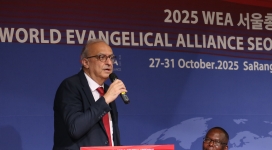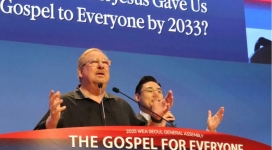
Japan’s Emperor Akihito on Wednesday expressed deep concern over the nation’s escalating nuclear crisis and said he was praying for the safety of people.
It was the first time in the history of Japan that the emperor addressed his nation on television during a crisis, according to the country’s Imperial Household Agency. Akihito, 77, told the public that he was “deeply worried” about the nuclear crisis, which escalated to the point that plant workers had to be temporarily evacuated on Wednesday.
“The number of people killed is increasing day by day and we do not know how many people have fallen victim,” Akihito said.
“I pray for the safety of as many people as possible,” he said.
He also mentioned the severe conditions that survivors are living in – bitter cold and shortage of water and fuel – and said, “I cannot help praying that rescue work is done swiftly and people’s lives get better, even a little.”
By Wednesday afternoon, the official death toll had soared to 3,676 confirmed dead and 7,558 unaccounted for, according to the nation’s police agency. But authorities say it is likely that more than 10,000 people died in the 8.9-magnitude earthquake and tsunami disasters that struck the nation on March 11.
The United States Geological Survey recorded 54 aftershocks in Japan by midafternoon Wednesday. Four of the earthquakes had magnitudes greater than 6.0.
“I hope from the bottom of my heart that the people will, hand in hand, treat each other with compassion and overcome these difficult times,” Akihito said in the video message.
The emperor particularly highlighted the “unpredictable” situation at the Fukushima Daiichi nuclear power plant about 150 miles north of Tokyo. Another fire broke out at the facility early on Wednesday at reactor No. 4.
The situation at No. 4 is “not so good” and No. 3 is the “priority,” said a plant operator, according to Reuters.
Since the twin disasters on Friday, workers have been frantically trying to cool down the rods to avoid a potential nuclear meltdown.
On Tuesday, authorities reduced the 750 workers at the power plant down to 50. And all of the remaining workers were temporarily evacuated Wednesday because the radiation levels were dangerously high.
In the video message, the emperor thanked domestic and international rescue workers who are responding to the disaster.
Among the relief groups responding to the disaster is the Baptist Global Response team of the Southern Baptist Convention. The team arrived in Tokyo on March 12 but said the nuclear threat is complicating their relief efforts.
“When most disasters occur, a single event is normally accompanied by a fairly set list of accompanying effects. Floods will leave mud, destroy crops, damage homes, contaminate water supplies, and cause sicknesses,” explained Pat Melancon, BGR disaster management specialist, on Tuesday. “When earthquakes occur, you see some of the same results, with additional problems like interrupted transportation, widespread structural damage or destruction, and the like.
“The Japan event, however, is different. Here we have three catastrophic events: the earthquake, which did much damage in areas not being featured in the news; the tsunami, which hit the low coastal areas of Japan especially hard; and now an additional unfolding event – the demise of nuclear power plants.”
Melancon said the Japan disaster “is unlike any other in recent history.”
An estimated 850,000 households in northern Japan still do not have electricity despite freezing temperatures, said Tohuku Electric power Co. according to Reuters. And the government said 1.5 million households or more do not have running water.





![[Exclusive Interview] Evangelist Stephen Tong exhorts the Chinese church to return to the foundations of reformed faith](https://www.gospelherald.com/media/cache/thumbnail/7/23/72340sp_273w_150h_1x_1y.png)

![[Exclusive] Rev. Dr. Richard Tin-Wo Cheung: walking between “charismatic” and “evangelical”](https://www.gospelherald.com/media/cache/thumbnail/7/23/72338sp_273w_150h_1x_1y.jpg)